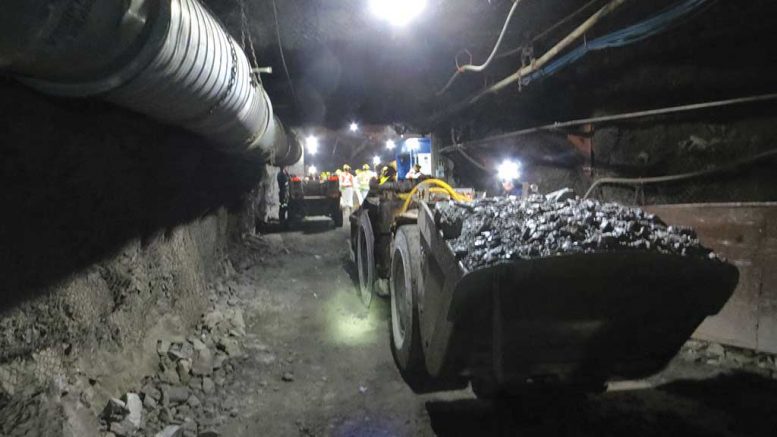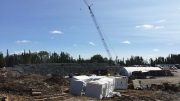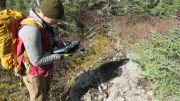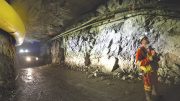VANCOUVER — Kirkland Lake Gold (TSX: KLG) has been on a tear in 2017 thanks to high gold grades and strong operating performances at its two flagship assets: the Macassa operation in Ontario, and the Fosterville mine in Australia’s Victoria state.
The company has gained in excess of 120% over the past seven months, en route to a 52-week high of $16.27 per share at press time.
Kirkland produced nearly 291,000 oz. gold over the first half of 2017 at all-in sustaining costs (AISCs) of US$803 per ounce. The performance was largely underpinned by rising grades at Fosterville, which cranked out 77,000 oz. during the second quarter at AISCs of US$388 per oz. sold.
The company generated US$45 million in free cash flow and net earnings of 17¢ per share during the three-month period.

Kirkland Lake Gold’s Fosterville gold mine in Australia. Credit: Kirkland Lake Gold.
Kirkland boosted its annual guidance to between 570,000 and 590,000 oz., with Fosterville scheduled to produce 50,000 oz. more gold than expected. The company dropped its overall AISC estimates for the year by US$50 to between US$800 and US$850 per ounce.
Kirkland also repurchased 1.3 million shares during the second quarter via a normal course-issuer bid launched in May.
“The ability to generate substantial free cash flow is the key to achieving growth through exploration and project development. We’ve also reduced our debt, and reward our shareholders through the repurchase program,” president and CEO Anthony Makuch said during a conference call.
“We are pleased with the performance in virtually every area. Fosterville had an outstanding quarter, with grades consistently outperforming our forecasts — in some cases by a large margin. In addition, the new underground mineral reserves estimate for the project more than doubles the number of ounces and comes very close to doubling the average grade,” he added.
Fosterville hosts 2.4 million proven and probable tonnes at 15.3 grams gold per tonne for 1.2 million contained ounces. The result marks a 110% increase in reserves and 83% boost in average grade, with the growth attributed to “down-plunge extensions of the high-grade, visible gold-bearing [Lower Phoenix gold zone], and the discovery of the visible, gold-bearing Harrier zone.”
Lower Phoenix’s crown jewel is the Swan zone, which boasts proven and probable reserves of 532,000 oz. gold at an average grade of 58.8 grams. In August, Kirkland released results from 2,600 metres of drilling at Swan, which were headlined by 33.6 metres grading 338 grams gold from 353 metres deep in hole 2081A.

Ball mills spinning at Kirkland Lake Gold’s Macassa gold-processing facility in northern Ontario. Credit: Kirkland Lake Gold.
“We continue to see significant potential to add more reserves and resources through additional extensions down-plunge at the Lower Phoenix and Harrier South gold systems,” Makuch said. “We also have other promising targets in and around these deposits, and have a large number of district targets within our 500 sq. km land position.”
Kirkland has cut production costs at Macassa while expanding production. The mine generated 45,700 oz. during the second quarter, which marked a 17% increase over the same period in 2016. The company dropped operating costs by 20% to US$512 per ounce.
Kirkland has also reported exploration success at its newest producer: the Taylor underground operation near Matheson, Ontario. It has drilled over 22,000 surface metres and 2,500 underground metres at the site so far this year. On Aug. 11, the company released assays from drill collars 1.8 km east of its Shaft deposit. The results were highlighted by 38 grams gold over 3 metres from 265 metres deep in hole 17-085.
“The results continue to highlight the potential that exists to identify new deposits east of Taylor along the [Porcupine Destor Fault],” Makuch said.
“As well, based on recent drilling, we are increasingly confident that we can add to our mineral resource and reserves in and around the Shaft deposit, as well as the East and West Porphyry deposits,” he continued, noting that all the areas are near existing infrastructure.
Taylor is expected to yield between 50,000 and 55,000 oz. gold this year.
Kirkland reported cash and equivalents of US$267 million at the end of the second quarter, and paid its first quarterly dividend of 1¢ per share. At press time the company had 209 shares outstanding for a $3.4-billion market capitalization.






Be the first to comment on "Kirkland Lake rides high grades towards banner year"